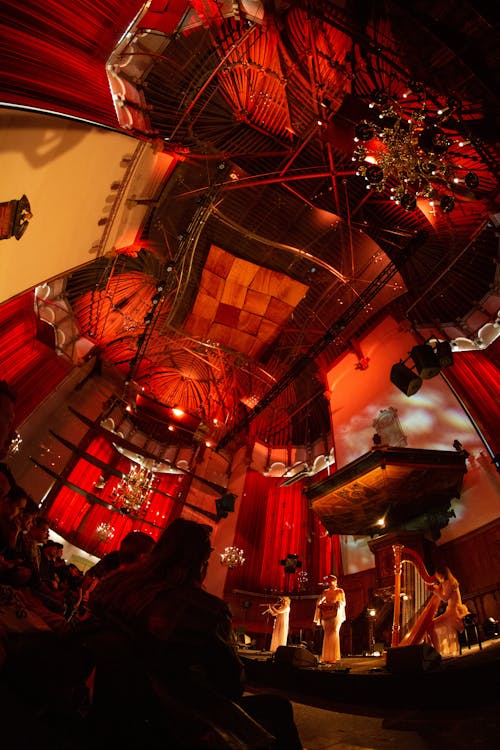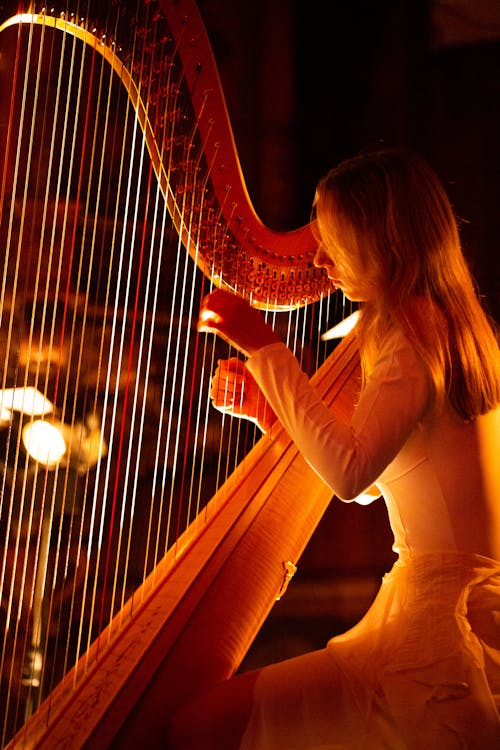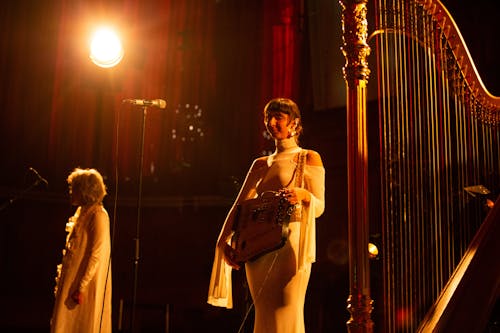Antonina Nowacka, Anne La Berge & Doriene Marselje reflect on SHAPE+ residency
Antonina Nowacka is a vocalist, composer, and sound artist who draws on the aesthetics and acoustics of the environment. Her music peels back the layers of life to unveil the simple truths hidden just beyond the veil. Nowacka's masterful blend of new age and experimental choral music allows her voice to shine – providing a beacon of imagination and possibility in these uncertain times.
At Rewire 2025, she partook in a SHAPE+ residency alongside accompanied by flutist, composer, and improviser Anne La Berge, and harpist Doriene Marselje, and they performed a special concert together. Rewire invited the three artists to reflect on their experiences of collaborating at the festival.
You were brought together at Rewire 2025 to partake in a SHAPE+ residency – the outcome of which was a spellbinding performance in The Hague's Nieuwe Kerk. Can you share a bit about what your experiences of this residency were like? How was it to collaborate?
Antonina: For me it was a beautiful experience – the venue was stunning and had incredible acoustics, it was one of the best spaces I have ever performed and I am so grateful for this opportunity. Doriene and Anne are both really wonderful and lovely musicians, with a lot of sensitivity, openness, and understanding. They are masters in their profession and I felt quite intimidated to work with them as my background is in visual arts. However, they were so comforting and I really found it easy to communicate my ideas. I felt our performance was relaxed, subtle and magical – the qualities I value dearly.
Anne: We only had a couple of sessions to bring our expertise and our musical ideas together to help Antonina co-create a set that was based on her music. The collaboration was guided by Antonina with contributions and ideas to support her work from Doriene and I. It was a great pleasure to get to know both of them, although it was a fleeting experience considering the time constraints. We were all open and willing to share ideas and experiment within limits.
Doriene: I really enjoyed working with Antonina and Anne on this concert, and I’m grateful that Rewire brought us together! Since Anne and I were primarily supporting Antonina’s concept, it would have been great to have had more time to explore her musical ideas in depth. At the same time, the limited rehearsal period meant we didn’t over-analyse every detail, which actually kept the performance feeling very pure and honest.

Each of you, in your independent practices, work in the breathing spaces between careful microtonality and emergent maximalism. How do you balance the desire for largeness and scale with the necessity for restraint and subtlety – particularly when coming to a collaboration such as this?
Antonina: I really believe in minimalism and that in a small gesture it is possible to bring something of a great power and great value. For me, the beauty of this collaboration lies in that we are all sensitive creatures and we can allow our vulnerability to speak out. It is the beauty of authenticity and simplicity that is something universal, a matter of a pure heart.
Anne: My priority is that the music balances the micro-material in the moment, the larger time-frame, and the acoustics of the performance. I see microtonality as tuning: a physical response to the physics of sound and the acoustic results. All music is microtonal to me. Since both Doriene and Antonina were using string instruments with fixed tunings, the subtle microtunings were simply tunings that gave the ensemble its needed character to fill the space. Changes were important to travel through time without stagnation. I see the emergent maximalism in this case as stretched time using minimal material that took a journey through subtle changes for a half hour. There are so many techniques to create forward motion in minimal music. Antonina approaches time and structure in an intuitive way that Doriene and I supported by following her structural ideas and her musical ideas during the performance.
Doriene: I think I’m on the opposite end of the musical spectrum from Antonina, which made it really interesting to explore what we could create within her language. It was incredibly valuable to work with someone as intuitive as she is – even if she doesn’t use "professional" musical terminology, her ideas and vision were always very clear. I’ve done many interdisciplinary collaborations over the years, and what drives me is a deep interest in how others see and express things. That kind of exchange is incredibly valuable to me.

There is a strong sense of place in your music, Antonina. Your latest album, Sylphine Soporifera (2024), was inspired by the desert landscape of Paracas and the undulating tree-less hills of the Outer Hebrides. Can you speak to what it feels like to travel with these songs, and perform them in different contexts, surroundings, and ecologies?
Antonina: It is all fluid and always transforming, the travels always bring new creations, new ideas, new visions. I never perform my albums in original form, as it is on the record; compositions transform through time. I want to create a live experience that is unique for a moment and only possible in this space and in this time, with these people. Compositions that are pleasant, meditative for the audience as well as for the performers and include the element of their uniqueness. For example, during the rehearsals I noticed Anne was able to play really beautiful, airy, flageolet-like harmonics and I decided to make the whole intro based on these sounds. The space of the performance is also so important as it brings another level to the experience. Marvelous, surreal spaces contribute with marvelous and surreal frequencies, and their visual aspect creates a scene that can change the perception of the whole séance into something from a dream world.
And for Anne and Doriene, in what ways does the Dutch landscape factor into your compositions, improvisations, and music? And, when working with such site-specific music from another artist, what kind of middle grounds and in-between spaces do you find yourselves in – sonically, aesthetically, or in terms of where you take the music and how you communicate with one another?
Anne: I see the Dutch landscape as one of many that I have lived in and intimately experienced. It is home and not home since I am an immigrant. The close proximity of human influences in the Dutch landscape has inspired me to create work that explores and makes comment on the complex and entangled relationships we have here with energy including sun, wind and gas; transportation on water and land, boats and trucks; ever-present wind and water, and the fantasy that the Netherlands has nature since it is a completely settled geography here. These conditions and the human uses of land and water and air have influenced and inspired a number of my works.
Antonina brought musical material to our collaboration that I felt was personally inspired and came from her desire to create a set of beautiful and moving sounds. We did not discuss spaces and places except the church that we would be performing in and our clothing. We were able to clearly communicate through sound and some words. I appreciated that the bulk of our collaboration was communicating through listening and picking and choosing what worked by simply playing together. We found enough connection in our short residency to bring Antonina's music to our audience.
To answer the question regarding working with site-specific music from another artist: it is of utmost importance to understand what the space can offer in terms of acoustics and vibe, to listen to what the space gives and what the space needs to let the music flourish. It is also essential to keep an empathic connection with my fellow musicians and with the audience. I am less concerned with analytically reflecting on the aesthetic and more focussed on what the music needs in the specific time and place we are playing. Aesthetic differences are part of life as an artist. They are a driving force for all of us since it is the differences that give us identity.
Doriene: My last (and current) solo show is actually called In a Landscape, partly because I perform with a 30-lamp modular light installation that, in my mind, resembles a landscape. The lights respond to the frequencies of the harp, creating an interplay between sound and visual elements. I believe that because the music isn’t tied to a fixed image, but rather offers an experience, it invites the audience to imagine their own version of the landscape. When I think about nature or landscapes, it’s often in abstract terms – more about emotions and sensations than literal imagery.

You're each accomplished solo artists in your own right. Looking back, what did each of you take away from the experience of working and performing together? And what kind of advice would you give to artists seeking pathways into fruitful collaboration?
Antonina: For me it was a beautiful, radiant memory of creating a dream-like experience with two other, amazing musicians and human beings. Something magical, eternal, and honest, something of a light matter. Such experiences are a nourishment to my soul and spirit, they simply make me happy, satisfied, and fulfilled in life. I would advise all artists to make things that make them feel this way.
Anne: It was a joy to collaborate with both Antonina and Doriene since I have never met them before, although Doriene and I have close mutual colleagues. I found entering Antonina's world inspiring in that she makes music by doing rather than carrying the responsibility to integrate years of training and artistic baggage into her work. This was a fresh experience, even though I have had many collaborations with artists whose backgrounds are dissimilar to mine. I took away the pleasure of putting together a set in a short time that was able to support Antonina's musical voice.
My advice to artists is to come together with openness and still make sure all collaborators' ideas and sounds are clear and can be talked about. When the chances arise, even if they are small, take risks and test out what works and/or does not work, and look closely at both options since something that does not work in one moment may work in another. Be generous. Be willing to puzzle. Make sure you are true to yourself.
Doriene: It was exciting to collaborate with an artist who has such a different musical perspective, yet shares a similar vision of the audience experience. I learned a lot! My advice would be to stay open-minded and willing to try things you haven’t done before. Let others guide you in their areas of expertise – I’m a firm believer in multidisciplinary creation, and how much it can enrich your own work.
Are there any final thoughts you'd like to share? Or exciting things over the horizon that you're looking forward to?
Antonina: I would like to thank the Rewire team for this opportunity and I hope we will have other occasions to perform together in another amazing spaces!
Anne: We were required to wear white for the performance, and in the Netherlands wearing white is tricky since we ride our bikes all the time. I am looking forward to tie-dying my white dress. I am working on a piece with a team of visual artists about the Wind Line in the north of the Netherlands where we research and show the place, the stuff and the earth in relation to wind energy, wind turbines, the land, and the water. Your questions about collaboration and site specific projects apply directly to this project.
Doriene: I look back on this experience with a deep sense of connection and gratitude – it was a beautiful concert. Thank you, Rewire! I’m now looking forward to working on a new solo project . . . and maybe even a new album!
SHAPE+ is co-funded by the European Union. Views and opinions expressed are however those of the author(s) only and do not necessarily reflect those of the European Union or the European Education and Culture Executive Agency (EACEA). Neither the European Union nor EACEA can be held responsible for them.
Photos by Kamiel Scholten